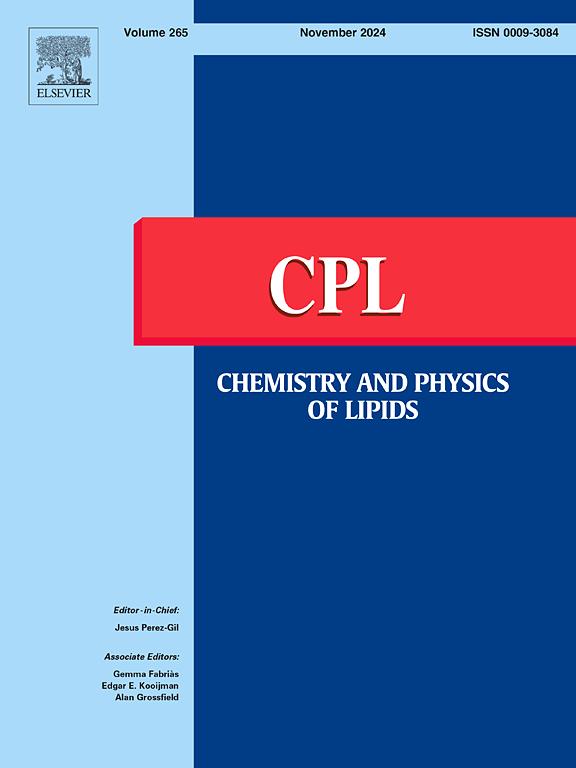脂膜组成调节扁柏醇对角质形成细胞和成纤维细胞的影响
IF 2.8
3区 生物学
Q2 BIOCHEMISTRY & MOLECULAR BIOLOGY
引用次数: 0
摘要
扁柏醇是一种用于化妆品的天然抗菌剂。提出的研究的目的是深入了解在模型膜中的脂质的相互作用,并将其与杉木醇对细胞的选择性作用联系起来。为了达到这一目标,我们使用角质形成细胞和成纤维细胞系评估了扁柏醇的毒性,并对脂质单层(单组分和混合系统)进行了研究。在研究过程中,进行了表面压力面积测量、渗透研究和布鲁斯特角显微镜实验。通过对实验数据计算参数的分析和BAM图像的对比,证明在与膜相关的表面压力下,扁柏醇不会插入到模型角质形成细胞和成纤维细胞的膜中,对这些系统的影响非常微弱。这一重要结论与体外实验有关。单组分体系的结果证明,扁柏醇对哺乳动物脂膜的影响取决于单层组织和脂质结构(特别是脂质极性头)。因此,脂类的种类和比例决定了桧木醇对混合膜的影响。后者证实了与哺乳动物脂类相比,扁柏酚对细菌的影响存在差异。结果表明,与哺乳动物细胞及其相应的模型膜相比,桧木醇对细菌细胞具有选择性。因此,与对皮肤细胞的毒性相比,扁柏醇的抗菌特性的优势可能与这种化合物与膜脂的相互作用有关。本文章由计算机程序翻译,如有差异,请以英文原文为准。
Lipid membrane composition modulates Hinokitiol's effects on keratinocytes and fibroblasts
Hinokitiol (β-thujaplicin) is a natural antimicrobial agent used in cosmetics. The aim of presented studies was to gain insight into the interactions of hinokitiol with lipids in model membranes and to correlate this with the selective effect of hinokitiol on cells. To reach this goal, the toxicity of hinokitiol was evaluated using keratinocyte and fibroblast cell lines, and studies were performed on lipid monolayers (both one component and mixed systems). During investigations the surface pressure - area measurements, penetration studies and Brewster angle microscopy experiments were done. The analysis of the parameters calculated from the experimental data and the comparison of BAM images evidenced that, at membrane – related surface pressure, hinokitiol does not insert into model keratinocyte and fibroblast membranes and its impact on these systems is very weak. This important conclusion correlates with the in vitro experiments. The results for one component systems evidenced that the effect of hinokitiol on mammalian lipid films depends on the monolayer organisation and the lipid structure (especially the lipid polar head). In consequence, the type and proportion of lipids determines the effect of hinokitiol on the mixed films. The latter corroborates with the differences in the influence of hinokitiol on bacteria compared to mammalian lipids. It was concluded that hinokitiol exhibits selective activity toward bacterial cells compared to mammalian cells and their corresponding model membranes. Thus, the predominance of hinokitiol's antibacterial properties over its toxicity to skin cells may therefore be related to interactions of this compound with membrane lipids.
求助全文
通过发布文献求助,成功后即可免费获取论文全文。
去求助
来源期刊

Chemistry and Physics of Lipids
生物-生化与分子生物学
CiteScore
7.60
自引率
2.90%
发文量
50
审稿时长
40 days
期刊介绍:
Chemistry and Physics of Lipids publishes research papers and review articles on chemical and physical aspects of lipids with primary emphasis on the relationship of these properties to biological functions and to biomedical applications.
Accordingly, the journal covers: advances in synthetic and analytical lipid methodology; mass-spectrometry of lipids; chemical and physical characterisation of isolated structures; thermodynamics, phase behaviour, topology and dynamics of lipid assemblies; physicochemical studies into lipid-lipid and lipid-protein interactions in lipoproteins and in natural and model membranes; movement of lipids within, across and between membranes; intracellular lipid transfer; structure-function relationships and the nature of lipid-derived second messengers; chemical, physical and functional alterations of lipids induced by free radicals; enzymatic and non-enzymatic mechanisms of lipid peroxidation in cells, tissues, biofluids; oxidative lipidomics; and the role of lipids in the regulation of membrane-dependent biological processes.
 求助内容:
求助内容: 应助结果提醒方式:
应助结果提醒方式:


